DOOM
If you’re a fanatical video gamer, then this word is reminiscent of one of the most groundbreaking first person shooter video games of all time.
If you’re an old school professional wrestling fan, this word reminds you of the NWA tag team comprised of Butch Reed and Ron Simmons back in the late 1980s.
If you’re like me, Doom stands for one thing in particular: the most powerful control force in Vs. System.
And You Thought Vidi Wijaya was on a Roll . . .
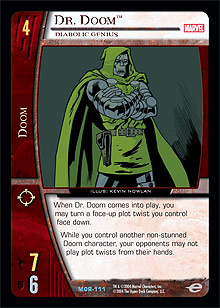 There can be little argument that Dr. Doom is one of the most influential characters in competitive Vs. System play. In all four Pro Circuits in which Marvel Origins has been legal, Dr. Doom has seen play in at least one deck in the Top 8. And in two of these Pro Circuits, PC: Indy 2004 and PC: Los Angeles 2005, a deck that featured Doom won the whole thing. Perhaps most importantly, Dr. Doom was the centerpiece character for three different decks that have seen Day 3 success in Golden Age PCs: Mono Doom, Common Enemy, and New School. Suffice to say, no other character has played such a pivotal role as an engine for powerful Vs. System decks as successfully as the Lord of Latveria has.
There can be little argument that Dr. Doom is one of the most influential characters in competitive Vs. System play. In all four Pro Circuits in which Marvel Origins has been legal, Dr. Doom has seen play in at least one deck in the Top 8. And in two of these Pro Circuits, PC: Indy 2004 and PC: Los Angeles 2005, a deck that featured Doom won the whole thing. Perhaps most importantly, Dr. Doom was the centerpiece character for three different decks that have seen Day 3 success in Golden Age PCs: Mono Doom, Common Enemy, and New School. Suffice to say, no other character has played such a pivotal role as an engine for powerful Vs. System decks as successfully as the Lord of Latveria has.
The recent release of the Heralds of Galactus set has opened a whole new floodgate of possibilities for team Doom. As I am sure that most of you are aware, Doom is one of the prominently featured teams in the new set, from which it received a lot of powerful new cards to supplement Dr. Doom, who is once again the core figure of the team. While Dr. Doom was always the central player of the team cards from Marvel Origins, many of the cards worked to use characters in unison to supplement his power. But there was always the understanding that, beyond all else, Doom was the man.
The cards from Heralds of Galactus take this concept in an even more extreme direction, cultivating an entirely new theme focused on Dr. Doom sacrificing other characters in play to enhance his own power base. From a flavor perspective, this is very apt, as Dr. Doom has never been shy about killing his own troops and allies to increase his stature. While KO’ing your own characters may seem somewhat counterproductive, Doom reaps tremendous benefits from doing so, including stat bonuses, character and plot twist search, and reuse of vital effects. If a ruler is willing to sacrifice his troops, then he can find many avenues to personal power.
Aggro vs. Control . . . You be the Judge
One thing in minor dispute is whether team Doom’s new inductees will shift the team from a control force to a more aggressive group. There are certainly arguments to fit the latter theory; cards like Doomstadt, Castle Doom; Doom Only Needs Doom; and Doomed Earth provide enormous ATK support for the team’s aggressive KO theme. Still, it seems that the control element of Doom was favored equally with cards like Astral Suppression, Expendable Ally, and Time Thief. In the end, it really is a matter of preference.
My personal preference leans toward the control side of the equation. You see, there are many teams in Vs. System that can play aggro as effectively as (if not more so than) Doom. Yet there are very few (if any) teams that can control the pace of play as well as Doom. X-Stall seemed to incorporate elements of Doom stall strategy to great success, and G’Lock utilized an additional element of endurance gain that helped players reach later turns. Ultimately, though, cards like Reign of Terror and Mystical Paralysis are just too awesome to ignore and make Doom the most powerful and versatile team in terms of controlling the pace of a game.
Multi-Doom-Tasking
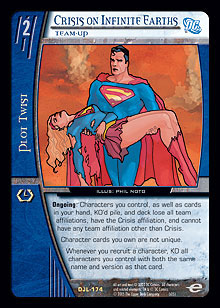 Even prior to the release of Heralds of Galactus, there had been much discussion on the prospect of using Crisis on Infinite Earths to make different versions of Dr. Doom non-unique to one another. After all, if one Dr. Doom was good, two or three should be even better. One consideration, though, was that Dr. Doom’s most potent effects stemmed from having Doom team characters in play with him. Take Dr. Doom, Diabolic Genius, for example. While his ability to allow a player to “recycle” a plot twist is indeed awesome, his notoriety stems from his ability to prevent opponents from playing plot twists from their hand. In order to make multiple Dooms truly effective, a player would need a way to move Crisis on Infinite Earths in and out of play at will to keep the Doom team affiliation in play while still avoiding uniqueness issues. Sadly, there really wasn’t an effective method of accomplishing this . . . until now.
Even prior to the release of Heralds of Galactus, there had been much discussion on the prospect of using Crisis on Infinite Earths to make different versions of Dr. Doom non-unique to one another. After all, if one Dr. Doom was good, two or three should be even better. One consideration, though, was that Dr. Doom’s most potent effects stemmed from having Doom team characters in play with him. Take Dr. Doom, Diabolic Genius, for example. While his ability to allow a player to “recycle” a plot twist is indeed awesome, his notoriety stems from his ability to prevent opponents from playing plot twists from their hand. In order to make multiple Dooms truly effective, a player would need a way to move Crisis on Infinite Earths in and out of play at will to keep the Doom team affiliation in play while still avoiding uniqueness issues. Sadly, there really wasn’t an effective method of accomplishing this . . . until now.
The new versions of Dr. Doom not only allow for more drops of Doom along the standard curve, but they also boast effects that allow players to manipulate activity in the resource row far more effectively than before. Where we might have had to rely on Have a Blast! or other replacement effects to support a multi-Doom strategy with Crisis on Infinite Earths before, we can now use the resource row control abilities to manipulate the use of the Team-Up. In essence, the goal of having multiple copies of Dr. Doom in play is more achievable than ever.
It’s time. We’re going to merge the cards from Marvel Origins Doom with the cards from Heralds of Galactus Doom to create a super Doom team with copies of Dr. Doom at multiple drops. With the help of Crisis on Infinite Earths, we should be able to flood the board with more copies of Dr. Doom than any opponent can possibly handle!
The Build
If you’ve ever played any sort of Doom control variant, then you’ll see that many of our choices will be intuitive. After all, what would Dr. Doom do without his man Boris, Personal Servant of Dr. Doom? Dr. Doom has some of the best plot twists in the game by far. With Boris by his side, the evil doctor can work his mischief by having his personal servant fetch the plot twists while he schemes.
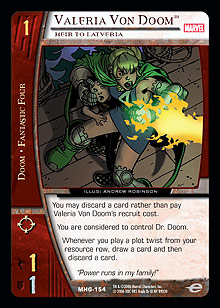 Also at 1, we have the heir to the throne, Valeria Von Doom. Is there anything bad about this card in this deck? I could talk for a while about how good Valeria Von Doom is, but I will keep my discussion limited to a few distinct points. First, when Valeria is in play, you are considered to control Dr. Doom. Anyone who knows anything about playing Doom knows how valuable this can be; cards like Boris and Faces of Doom can only be used if a player controls Dr. Doom. Secondly, she has a relevant ability. While it is not card drawing per se, her effect still allows us to cycle through our deck for additional cards that might be useful to us. Finally, she is a free recruit. Any character that has an alternate recruit cost is one that should find play in at least a few decks. In this deck, having a character that can be recruited for free is particularly relevant, as several effects stem from KO’ing characters that we control. With Valeria’s free recruit, we can bring out a character to KO without having to lose board position. Granted, it does seem a little morbid that Dr. Doom would be knocking off his own daughter to achieve his dark ends, but then again, he is Dr. Doom.
Also at 1, we have the heir to the throne, Valeria Von Doom. Is there anything bad about this card in this deck? I could talk for a while about how good Valeria Von Doom is, but I will keep my discussion limited to a few distinct points. First, when Valeria is in play, you are considered to control Dr. Doom. Anyone who knows anything about playing Doom knows how valuable this can be; cards like Boris and Faces of Doom can only be used if a player controls Dr. Doom. Secondly, she has a relevant ability. While it is not card drawing per se, her effect still allows us to cycle through our deck for additional cards that might be useful to us. Finally, she is a free recruit. Any character that has an alternate recruit cost is one that should find play in at least a few decks. In this deck, having a character that can be recruited for free is particularly relevant, as several effects stem from KO’ing characters that we control. With Valeria’s free recruit, we can bring out a character to KO without having to lose board position. Granted, it does seem a little morbid that Dr. Doom would be knocking off his own daughter to achieve his dark ends, but then again, he is Dr. Doom.
At 2, we have one of the Doom deck mainstays in Puppet Master. No . . . Puppet Master is not team stamped to the Doom team. But he might as well be, as his effect supports the Doom stall theme so well that he has long been an automatic inclusion in late-game Doom decks. It is somewhat ironic that our other 2-drop, Rama-Tut, has seen less play in Doom decks than Puppet Master despite the fact that Rama-Tut is a Doom character. Still, this incarnation of Kang has an effect that is particularly relevant to our build, as we will be using and reusing several different plot twists. So powerful is this effect that we will not only consider under-dropping for Rama-Tut, but we will actually plan on doing so at one point in the curve.
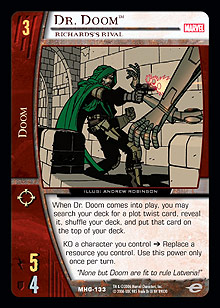 Turn 3 is where Dr. Doom takes over. Dr. Doom, Richards’s Rival is a welcome addition to the Doom clan with an effect that facilitates the use of premium plot twists by the Doom team. The 3-drop Doom excels at setting us up for powerful turn 4 plot twists like Reign of Terror by putting them on top of the deck for easy access on the next draw. Of course, if we need immediate access to a plot twist or simply want to move a character like Puppet Master or Rama-Tut out of harm’s way, then we can KO a character to replace a resource with the plot twist that we set up there. This can be a great play with cards like Mystical Paralysis, Flame Trap, and Crisis on Infinite Earths. But I would highly advise against replacing with Reign of Terror!
Turn 3 is where Dr. Doom takes over. Dr. Doom, Richards’s Rival is a welcome addition to the Doom clan with an effect that facilitates the use of premium plot twists by the Doom team. The 3-drop Doom excels at setting us up for powerful turn 4 plot twists like Reign of Terror by putting them on top of the deck for easy access on the next draw. Of course, if we need immediate access to a plot twist or simply want to move a character like Puppet Master or Rama-Tut out of harm’s way, then we can KO a character to replace a resource with the plot twist that we set up there. This can be a great play with cards like Mystical Paralysis, Flame Trap, and Crisis on Infinite Earths. But I would highly advise against replacing with Reign of Terror!
It is probably no surprise that our turn 4 play is Dr. Doom, Diabolic Genius. This unassuming 7 ATK / 6 DEF 4-drop is still one of the best 4-drops in the game. We discussed his effects a bit earlier in the article. What’s important to note is that this is where our interaction with Crisis on Infinite Earths comes into play. To avoid uniqueness with our 3-drop, we must have Crisis on Infinite Earths face-up in play before we recruit our 4-drop. In fact, it would probably behoove us to have a couple of copies in our row to prevent any opposing shenanigans with replacement effects. Once we have successfully recruited Dr. Doom, Diabolic Genius, we can use either Dooms’ effect to deal with Crisis on Infinite Earths. The 4-drop could easily flip it down so that we can reuse it in later turns with our late-game Dr. Doom recruits. But if we find that we need to recycle a different plot twist, then we can simply replace Crisis on Infinite Earths with the effect of Dr. Doom, Richard’s Rival. Either way, we have created a situation where we have bypassed Dr. Doom’s uniqueness while allowing the Doom team affiliation to find play.
At 5, we have no version of Dr. Doom to fill the slot. While we could include a non–Dr. Doom 5-drop, it would probably serve us better to do our aforementioned under-dropping here. After establishing board presence on turn 4 with Dr. Doom, Diabolic Genius, we can recruit Boris and Rama-Tut to fetch additional plot twist for us and bring Puppet Master into play to keep our opponent’s board in check.
Turn 6 has a couple of options for us. In most cases, we should consider recruiting Dr. Doom, Victor Von Doom. Against Dr. Doom, Diabolic Genius, our opponent’s only recourse is to play plot twists from the resource row. If we can get the 4-drop Doom and Dr. Doom, Victor Von Doom in play together, then our opponents will be locked out of plot twists entirely! This, of course, assumes that we have a way of dealing with Crisis on Infinite Earths. But with the 3-drop Dr. Doom and our under-drops on turn 5, that shouldn’t be much of an issue.
But let’s consider the effectiveness of Dr. Doom, Victor Von Doom against a team like League of Assassins or Checkmate. What good is a character that prevents playing plot twists from the resource row when a team plays primarily locations? The answer: none! He is effectively a 6-drop with blank text. In this situation, Dr. Doom, Sorcerous Savant is our play. His stats are identical to Dr. Doom, Victor Von Doom’s, but he has an effect that would actually be relevant in the location-based matchups. In addition, Dr. Doom, Sorcerous Savant’s effect is a built-in answer for dealing with Crisis on Infinite Earths.
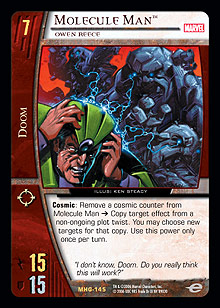 We have another version of Doom at 7 in Dr. Doom, Scientific Sorcerer. His primary appeal is that he shares the name of Dr. Doom with the rest of our characters, but his effect is not particularly relevant to our deck, as we are more stall focused. More importantly, his play on turn 7 would require us to consider additional action with Crisis on Infinite Earths. This is why we have a preferred 7-drop not named Dr. Doom in the form of Molecule Man. At the very least, Molecule Man is a vanilla 15 ATK / 15 DEF 7-drop with range. But his reason for inclusion is his effect, which is insane! As we have already discussed, many of the Doom plot twists are extremely powerful. Imagine now if you could play any one of those plot twists and get a free copy. Perhaps more importantly, Molecule Man’s effect doesn’t require a player to pay the costs of the plot twist’s effect. What does this mean? It means that you can use a card like Mystical Paralysis twice but only have to exhaust a single copy of Dr. Doom. Even though his effect is only a one-time deal for us, it is powerful enough to include Molecule Man within the ranks of the multi-Dooms.
We have another version of Doom at 7 in Dr. Doom, Scientific Sorcerer. His primary appeal is that he shares the name of Dr. Doom with the rest of our characters, but his effect is not particularly relevant to our deck, as we are more stall focused. More importantly, his play on turn 7 would require us to consider additional action with Crisis on Infinite Earths. This is why we have a preferred 7-drop not named Dr. Doom in the form of Molecule Man. At the very least, Molecule Man is a vanilla 15 ATK / 15 DEF 7-drop with range. But his reason for inclusion is his effect, which is insane! As we have already discussed, many of the Doom plot twists are extremely powerful. Imagine now if you could play any one of those plot twists and get a free copy. Perhaps more importantly, Molecule Man’s effect doesn’t require a player to pay the costs of the plot twist’s effect. What does this mean? It means that you can use a card like Mystical Paralysis twice but only have to exhaust a single copy of Dr. Doom. Even though his effect is only a one-time deal for us, it is powerful enough to include Molecule Man within the ranks of the multi-Dooms.
Our final character is the amazing Dr. Doom, Lord of Latveria. Just like all of our other versions of Dr. Doom, we will have to monitor our use of Crisis on Infinite Earths carefully to ensure that Dr. Doom, Lord of Latveria will not create uniqueness issues. Still, we would like to get as much out of our 8-drop as possible. In order to do so, we need a method of flipping down or replacing Crisis on Infinite Earths in response to the 8-drop Doom’s triggered effect. If we have Dr. Doom, Richards’s Rival or Dr. Doom, Sorcerous Savant in play, this is a relatively simple matter. In other situations, we may have to rely on Have a Blast! to replace our own Team-Up. In any case, once we have the 8-drop Doom in play with his smaller versions, we can commence the late game beatings.
Before we go to our plot twists, let’s talk about our sole location. What’s better than giving a single character +3 DEF all of the time? Giving all of our characters +3 DEF all of the time! This deck is the one that Doomstadt was made for. With an additional +3 DEF added to each of our major drops, opponents will usually be unable to make successful lateral attacks for a stun. In some cases, we can even eliminate attacks down the curve via the massive DEF bonus that Doomstadt provides. If you thought that Doomstadt was awesome before, you ain’t seen nothin’ yet!
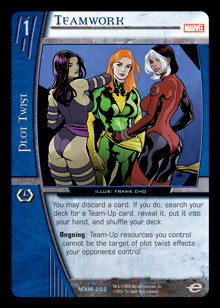 Now on to the all-important plot twists. We have discussed Crisis on Infinite Earths in great detail already, so it should be no surprise that we’ll be playing four copies of the Team-Up. Of course, because Crisis on Infinite Earths facilitates our entire deck, we should probably have some insurance to make sure that we hit our all-important enabler. Thus, we’ll also play a couple of copies of Teamwork. This nifty ongoing plot twist will allow us to search out copies of our critical Team-Up and prevent opponents from using replacement plot twists like Breaking Ground and War of Attrition to remove our Team-Up.
Now on to the all-important plot twists. We have discussed Crisis on Infinite Earths in great detail already, so it should be no surprise that we’ll be playing four copies of the Team-Up. Of course, because Crisis on Infinite Earths facilitates our entire deck, we should probably have some insurance to make sure that we hit our all-important enabler. Thus, we’ll also play a couple of copies of Teamwork. This nifty ongoing plot twist will allow us to search out copies of our critical Team-Up and prevent opponents from using replacement plot twists like Breaking Ground and War of Attrition to remove our Team-Up.
Now on to the plot twists that are affectionately referred to as the “Doom Suite.” Two plot twists in particular—Mystical Paralysis and Reign of Terror—are usually present in every deck that features Dr. Doom. Our build is certainly no different. We will be recruiting Dr. Doom several times in every game, so Reign of Terror could potentially be effective many times in any given game. And since we will usually have several characters named Dr. Doom in play, we should have no trouble exhausting multiple opposing characters with Mystical Paralysis.
Another card that isn’t as popular in the Doom Suite but is still occasionally present is Faces of Doom. In general, character search cards are placed at a premium. Faces of Doom is definitely a good call for our deck, as we have characters named Dr. Doom seeing play at several spots in the curve. Having a card that can fetch our 3-, 4-, 6-, 7-, and 8-drops with no requirements other than that we control Dr. Doom (which should be exceedingly simple for our deck) is going to be a very good play for us.
Now it’s time to discuss one of my favorite new cards from the Heralds of Galactus set, Expendable Ally. I can’t count the number of times that I have used Roy Harper ◊ Arsenal, Sharpshooter to neutralize an opposing Dr. Doom, Diabolic Genius. With the release of Heralds of Galactus, though, Arsenal is not nearly the threat that he once was. Not only does this card act as a Nice Try! for your characters named Dr. Doom (which we have plenty of in our deck), but it actually increases the threat of that character by giving him an additional +5 ATK. Let’s see . . . a card that makes our characters immune to opponents’ effects and gives us a permanent Savage Beatdown in the bargain? Yes, please! With the number of cards in Vs. System that target opposing characters, this card will be an MVP in our deck!
Finally, what would any Doom deck be without the plot twist tech cards that make it so versatile? One of the main reasons that Doom has been so successful on so many levels is that it has the ability to adapt to beat other decks. Here are the tech plot twists that we’ll include in our deck:
- Flame Trap: Reign of Terror can certainly stifle any off-curve deck. Still, against a deck like Faces of Evil that puts out so many small characters that even Reign of Terror can’t keep up, we might want a global board control card. Flame Trap is one of the most powerful off-curve control cards in Vs. System. The ability to stun all characters in play with a cost of 2 or less at any time is certainly a potent effect that merits inclusion in our control build.
- Have a Blast!: As we mentioned earlier, Have a Blast! can be our last resort for dealing with Crisis on Infinite Earths, should we find it necessary. But it is far more effective as a tool for disrupting strategies that rely on cards in the resource row. Combo decks like Rigged Elections and Xavier’s Dream are naturally vulnerable to replacement effects. And decks that rely on Team-Ups to operate effectively can be disrupted by replacing those Team-Ups. Finally, Have a Blast! provides us with a way to deal with problematic locations like Lost City that might otherwise overwhelm us.
- Meltdown: The tendency to lean toward equipment to boost character stats has recently become far more prevalent. Aggressive decks like Squadron Supreme and High Voltage use powerful equipment cards to boost characters stats and cause direct endurance damage. Perhaps even more importantly, some equipment cards that have appeared in recent sets can neutralize disruption effects (like Cloak of Nabu and Time Gem). Since our deck lives and dies on control and disruption effects, we should include a card to deal with these plot twists. Certainly, Meltdown is the perfect solution. If we run afoul of problematic equipment cards, it can dispatch them with ease. Otherwise, it can double as a makeshift endurance gain card or resource row replacement effect.
- Press the Attack: This card is not so much a tech card as an end-game enabler. New School showed the Vs. System public how potent the combo of Dr. Doom, Lord of Latveria and Press the Attack can be. If your opponent doesn’t have a way to bounce or stun the 8-drop Doom, then he can easily attack into infinity. While this combo is not as easily facilitated in our deck, it is still viable, so it’s worth including one copy of the infamous readying card.
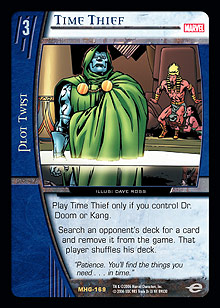 Time Thief: Consider bad matchups for any Doom stall deck. They usually involve playing more effective late game cards than the Doom deck. Without a doubt, G’Lock plying for a win with Captain Marvel, Champion of Magic is a difficult matchup for any Doom deck. So, how do you beat it? Just remove Captain Marvel from your opponent’s deck via Time Thief. This amazing card turns decks that rely on limited copies of a win condition into potential disasters. And with the reuse of plot twists available to the Doom deck, it is feasible to remove multiple copies of any card. So, unless your opponent is playing four copies of the Champion of Magic, he or she won’t be able to win via his effect!
Time Thief: Consider bad matchups for any Doom stall deck. They usually involve playing more effective late game cards than the Doom deck. Without a doubt, G’Lock plying for a win with Captain Marvel, Champion of Magic is a difficult matchup for any Doom deck. So, how do you beat it? Just remove Captain Marvel from your opponent’s deck via Time Thief. This amazing card turns decks that rely on limited copies of a win condition into potential disasters. And with the reuse of plot twists available to the Doom deck, it is feasible to remove multiple copies of any card. So, unless your opponent is playing four copies of the Champion of Magic, he or she won’t be able to win via his effect!
Doom has arrived, and he’s multiplying. Let’s take a look at our effort at a multi-Doom deck:
For The Love Of DOOM (60 cards)
Characters (29)
4 Boris, Personal Servant of Dr. Doom
4 Valeria Von Doom, Heir to Latveria
4 Puppet Master, Phillip Masters
4 Rama-Tut, Pharaoh from the 30th Century
4 Dr. Doom, Richard’s Rival
4 Dr. Doom, Diabolic Genius
1 Dr. Doom, Sorcerous Savant
1 Dr. Doom, Victor Von Doom
1 Dr. Doom, Scientific Sorcerer
1 Molecule Man, Owen Reece
1 Dr. Doom, Lord of Latveria
Plot Twists (27)
4 Crisis on Infinite Earths, Team-Up
4 Expendable Ally
4 Faces of Doom
1 Flame Trap
1 Have a Blast!
1 Meltdown
4 Mystical Paralysis
1 Press the Attack
4 Reign of Terror
2 Teamwork
1 Time Thief
Locations (4)
4 Doomstadt
For maximum control potential, we should try for the even initiatives. This will allow us to use Reign of Terror at our discretion. With a mediocre draw, we should be able to get rid of at least a few characters. With a good draw, we could feasibly clear our opponent’s entire board.
The mulligan condition is pretty much always going to be Dr. Doom, Richards’s Rival or a way to fetch the 3-drop (like Faces of Doom or Boris, Personal Servant of Dr. Doom). At the very least, we can use the 3-drop to put Faces of Doom on top of our deck so that we can fetch the all-important 4-drop. If we happen to miss Crisis on Infinite Earths, we shouldn’t suffer too much, as it is really only critical for later turns.
That about wraps it up for this week of Breaking Ground. Take care, and we’ll see you next week for another foray into the weird and wacky world of Vs. System deckbuilding!
Michael Barnes (a.k.a. BigSpooky) is an avid Vs. System player who is a founding member of Team Alternate Win Condition (TAWC). When he isn’t concocting crazy deck ideas that no sane person would think of, he occupies his spare time working as an accountant in Dallas, TX. Any questions, comments, suggestions, or diabolical plans for world domination that you might have for Michael can be sent to him at BigSpooky1@hotmail.com.